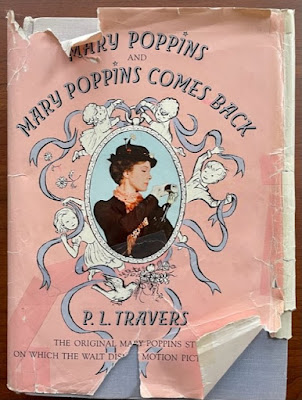 |
| My well-worn copy of Mary Poppins and Mary Poppins Comes Back |
I’d better hurry up and write about my
granddaughter before she forgets her story!
Since she was a few weeks old, C. has been whispering to the world as if she were confiding great wisdom. Speaking sotto voce in a just-between-us manner, C. seems to be sharing the secrets of the universe with anyone who will listen. She reminds me of Annabel.
Annabel was the youngest of the Banks children in the “Mary Poppins” books. Readers will have known her only as a baby. She has been mentioned in a few scholarly essays. Some critics have noted that her character is profound while others consider her trite. I don’t care either way.
From the first time I read about Annabel, I was hooked.
 |
| Inside cover of Mary Poppins |
The 1964 Disney film is familiar to millions who may not realize that it is based on a book by an English writer named P. L. Travers. Onscreen, the main characters are Jane and Michael Banks, their parents, and Mary Poppins.
If you’ve watched the film but never read the book, you would not know about the twins, John and Barbara. The truth is that they are rather colorless and it is understandable that Disney did not include them.
Annabel is different. She came along in Travers’ sequel, Mary Poppins Comes Back, published in 1935. This book opens with the unsupervised Banks children flying a kite in the park. The kite becomes lost in a cloud and won’t let itself be reeled in until bystanders gather to pull as hard as they can on the string.
Suddenly, an object bursts from the cloud and slowly descends to earth as the children make out a familiar shape.
“Ah!” Jane gave a shout of triumph. “It is she!”
And so it is. Mary Poppins has returned and will stay till the chain on her necklace breaks, she says.
Halfway through her second stay, Mary Poppins is handed an infant, Annabel, immediately after she is born to Mrs. Banks.
Presiding over Annabel in the children’s
nursery, Mary Poppins is joined periodically by an impertinent starling who
lives on top of the chimney and joyfully regards the infant as one of his own
fledglings. One day the starling brings along a young bird, who
asks where Annabel came from.
 |
| First pages of "The New One," chapter about Annabel |
In response, Annabel gestures with her hands—just like my granddaughter—and explains to the starlings:
"I came from the Dark where all things have their beginning . . . I come from the sea and its tides . . . I come from the sun and its brightness . . . Slowly I moved at first . . . always sleeping and dreaming. I remembered all I had been and I thought of all I shall be."
Later, when Jane and Michael and the twins crowd around Annabel, they ask where she came from. Happily, Annabel embarks on her story: “I came from the Dark—” But Jane interrupts.
“Such funny little sounds! I wish she could talk and tell us.” Annabel kicks her legs and starts to cry. After all, she is telling them where she came from.
My granddaughter manages to captivate every person who leans over and smiles at her. We listen raptly although we—grown, fumbling humans—do not understand what she is telling us. Whatever it may be, she expresses a certain urgency in sharing her thoughts.
Perhaps, like Annabel, she is saying: “I heard the stars singing as I came and felt warm wings about me.” But she will not recall her journey forever, as the starling realizes one day. With a tear in his eye, he exclaims to Mary Poppins:
“She’s forgotten it all. I knew she would. But, ah, my dear, what a pity!”
 |
| P. L. Travers' 1996 obituary, New York Times |
During the 1980s, as she entered her own 80s, the famously private Travers sat down to discuss the origin of Mary Poppins. The nanny was not a character she invented, Travers insisted; Mary Poppins grew out of the author’s longstanding interest in myths, fables, and rites of passage.
“I think if she comes from anywhere that has a name, it is out of myth,” she told the Paris Review in 1982.
And myth has been my study and joy ever since—oh, the age, I would think, of three. I’ve studied it all my life. No culture can satisfactorily move along its forward course without its myths, which are its teachings, its fundamental dealing with the truth of things, and the one reality that underlies everything.
In a 1988 essay, Travers described Annabel’s story perfectly: “There are worlds beyond worlds and times beyond times, all of them true, all of them real, and all of them (as children know) penetrating each other.”
Indeed, the “Mary Poppins” books delve deep
into symbols, mysticism, and transcendence. We just don’t realize it because
Travers was such a good storyteller. I hope my granddaughter will be one, too.
 |
| Many dissertations and books offer analyses of the Mary Poppins books. |
https://www.throughthehourglass.com/2023/01/the-new-one.html




No comments:
Post a Comment